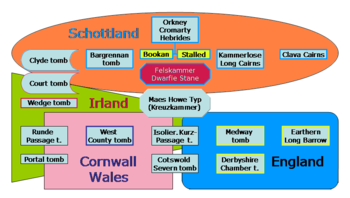British megalith architecture

British megalith architecture is the
The
The activities of megalithic cultures in the region dates back to
Exemplary in this respect are the "cruciform passage" sites of the
Neolithic monuments are an expression of the culture and ideology of Neolithic societies. Their origin and function are considered characteristic of social development.[1]
Dating
Well dated monuments, such as Street House in North Yorkshire and Hazleton North in Gloucestershire, indicate that the primary period of use, during which there were continual burials, perhaps lasted only two or three centuries. The small number of burials found in the West Kennet Long Barrow in Wiltshire seems to confirm this.
On the other hand, the Middle Neolithic pottery in the trenches of long barrows and the late dates of the hearths (Herde) on the forecourts of megalithic sites such as
Primarily in southern England, burial sites were deliberately closed. The time when this occurred is often uncertain. The chamber of the West Kennet Long Barrow seems to have been used for many centuries, but was eventually filled about 2400 B.C. Blocked access is often found in atria, indicating an end to the chamber's use, but the frequent presence of more than one layer indicates that these decisions were not final, making it difficult to determine the exact time when the tomb was finally abandoned. Particularly in Scotland (up to Shetland - Pettigarth's Field), there are a number of multi-period systems (English multi-period building), whereby round mounds had long barrows subsequently built over them (Grey Cairns of Camster) and heel-shaped cairns).
It is not clear whether any new monuments erected after about 3000 B.C. in southern England, although rituals continued to be held in the old ones. In the northwest, the old tradition probably lasted longer. The conversion of a classic
See also
- Ballowall Barrow
- Clava cairn
- Entrance grave Scilly Isles and Ireland
- Heel-shaped cairn
- Medway tomb
- Passage tomb
- Portal tomb
- Quoit
- Ring cairn
- Tor cairn
Also included are
- Non-megalithic long barrows
- Non-megalithic round barrows
- Unchambered long cairns
References
- ^ J. Müller In: Varia neolithica VI 2009 p. 15
Literature
- R. Cavendish Prehistoric England 1983
- B. Cunliffe & A. + G. Ritchie: Oxford Archaeological Guide, Scotland 1998 ISBN 0-19-288002-0
- F. Lynch: Megalithic Tombs and Long Barrows in Britain 1997 ISBN 0-7478-0341-2
- E. Shee Twohig: Irish Megalithic Tombs 1990 ISBN 0-7478-0094-4
- Jürgen E. Walkowitz: Das Megalithsyndrom. europäische Kultstätten der Steinzeit. Beier & Beran, Langenweißbach 2003, ISBN 3-930036-70-3.
